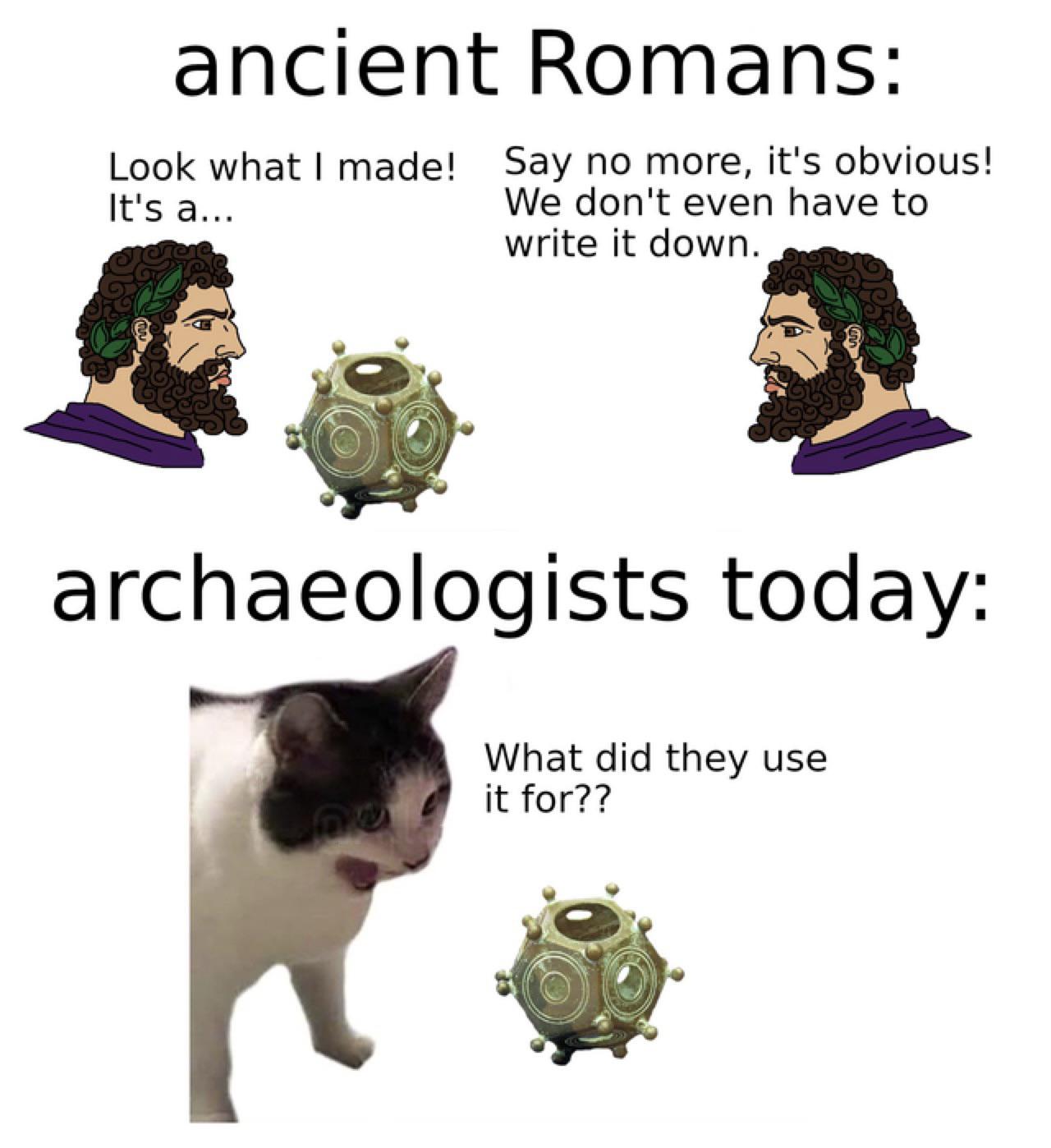"Everyone knows what a horse is"
-
I remember reading a book as a kid, I can't remember if it was this or maybe inspired by this, but adapted for kids (iirc the art style was more cartoony and comedic) where archeologists unearth a motel called the Toot and C'mon.
-
That is not an uncommon guess, but the argument against it is that these took some sophistication to make. This isn't some disposable gewgaw. These were made with relatively tight tolerances and exhibited the best metalworking fabrication of the age. One theory I've seen seriously floated was that they were made as a demonstration of metal working competency, the equivalent of a benchy in 3D printing.
Maybe they're just like the ancient equivalent of the fancy expensive gaudy crystal pieces you can get today.
God so many better ways to spend $1800
They probably just have no practical purpose.
-
That is not an uncommon guess, but the argument against it is that these took some sophistication to make. This isn't some disposable gewgaw. These were made with relatively tight tolerances and exhibited the best metalworking fabrication of the age. One theory I've seen seriously floated was that they were made as a demonstration of metal working competency, the equivalent of a benchy in 3D printing.
If that's the case, it could have been a craftsman's magnum opus. A certification you prominently display to show your wares aren't forgeries.
-
Gloves. There's several YouTube videos of people knitting gloves with them. If you use 5 holes, you'll end up with a slight curve to one side for free. You can use the hole-sizes as a guide for finger width. Most of the work is done by the nubs sticking out, which hold the outermost stitch.
-
Are you asserting that an ornament can't be categorized as a religious artifact? Cuz if so, I (or you) have some explaining to do.
-
Seems pretty convincing and matches gold bracelets made in the era.
-
Gloves. There's several YouTube videos of people knitting gloves with them. If you use 5 holes, you'll end up with a slight curve to one side for free. You can use the hole-sizes as a guide for finger width. Most of the work is done by the nubs sticking out, which hold the outermost stitch.
Romans quite literally did not knit.
-
Knitting metal: https://youtu.be/lADTLozKm0I?si=pKQ8Dwt7wriapdni
-
Knitting metal: https://youtu.be/lADTLozKm0I?si=pKQ8Dwt7wriapdni
-
I remember reading a book as a kid, I can't remember if it was this or maybe inspired by this, but adapted for kids (iirc the art style was more cartoony and comedic) where archeologists unearth a motel called the Toot and C'mon.
This guy did a bunch of kids books. My favorites were Castle and Pyramid.
-
Seems pretty convincing and matches gold bracelets made in the era.
I've actually seen an old lady knit gloves with one as well.
-
Ehh idk about this take. I agree with the article that there are some commercial historical mediums like the History Channel that interpret the past in an absurd/almost malicious way. However modern archaeology does a really good job of finding out how objects from the past were used and how people interacted with their environment. A toilet is not really gonna be up for debate as for what its use was. Historical text, fecal remains, toilets looking pretty similar for the past thousand years, is gonna tell you it’s a toilet.
The notion of our interpretation of the past being completely flawed is kinda true if it was like the 1950s and we were talking about non-western cultures from a western perspective.
-
Knitting metal: https://youtu.be/lADTLozKm0I?si=pKQ8Dwt7wriapdni
Also gloves: https://www.youtube.com/watch?v=76AvV601yJ0
-
Except there's heaps of them
-
Socks rarely last a year, fabrics existed in Rome, it's like not knowing if 2 + 2 equals 2 because there aren't any historical examples of people putting two and two together until the xth century AD.
-
Why wouldn't you use a simple flat metal bar, or even a ring shaped bar, with standard holes in it?
-
I always wondered how they made those
-
Socks rarely last a year, fabrics existed in Rome, it's like not knowing if 2 + 2 equals 2 because there aren't any historical examples of people putting two and two together until the xth century AD.
The reason that knitting isn't the currently accepted answer, is that its pretty well understood that in the periods where these are found, Romans quite literally did not knit.
-
The reason that knitting isn't the currently accepted answer, is that its pretty well understood that in the periods where these are found, Romans quite literally did not knit.
First of all, Wikipedia is not a source. All of the sources on Wikipedia are annotated in the text and listed at the bottom of the page. All you have to do is look down, get the actual source, and use that. You couldn't be bothered to do the bare minimum to give an argument but still waste time throwing out links to non-sources?
Secondly, from your "source":
These complexities suggest that knitting is even older than the archeological record can prove.[3]
Earlier pieces having a knitted or crocheted appearance have been shown to be made with other techniques, such as Nålebinding, a technique of making fabric by creating multiple loops with a single needle and thread, much like sewing.[4] Some artefacts have a structure so similar to knitting, for example, 3rd-5th century CE Romano-Egyptian toe-socks, that it is thought the "Coptic stitch" of nalbinding is the forerunner to knitting.
-
I thought for sure it would be this video


